Systemic Deliberate Indifference and Undercounting Prison Rape

Though it’s sixteen years after Farmer v. Brennan, when the Supreme Court (essentially) decided that allowing the rape of prisoners should be considered an advanced (and culpable) form of negligence, change has been slow to come. For one thing, no one really knows how many people are raped in the adult and juvenile systems each year. The Bureau of Justice Statistics is revising their surveys now; two of their recent surveys indicate that there are 165,400 acts of sexual abuse in their reporting period. (They use “snapshots” of a single day and then extrapolate.) But an evaluation of the methods used suggests that they may be drastically undercounting.
For one thing?
“Inmates who said they had been sexually abused were asked how many times. Their options were 1, 2, 3–10, and 11 times or more; that answers of ‘3–10’ were assigned a value of 5, and ’11 or more’ a value of 12. We know of no reason to think that answers of ‘3–10’ should be skewed so far toward the low end of the range, however-and inmates are sometimes raped many more than twelve times.”
And also challenging these numbers is the sheer volume of people who move in and out of jails; “The number of annual jail admissions is approximately seventeen times higher than the jail population on any given day.” How do you find the real numbers? Not sure, yet: “What is the right multiple-are five, six, seven times 24,700 people molested and raped in jail every year? We don’t know yet, but we hope to soon.”
Squalid Britons Extremely Casual About Hygiene

If you need yet more proof that the residents of Knifecrime Island are absolutely filthy individuals, here you go: “A poll suggests that more than half a million Britons only wash their sheets three times a year, allowing some 10 million bugs and dust mites to settle in for a night cap alongside them.” The poll reveals Londoners to be the most slovenly members of their verminous race, with almost 25% admitting that they only give their sheets a washing up every four months, which finally explains Dr. Johnson’s famous adage that “when a man is tired of London, he is — holy fuck am I itchy.”
It's Carnival Time!
Happy Mardi Gras! Should you be unable to make it to New Orleans today and too employed to start drinking properly until later in the evening, the Times-Picayune offers a variety of live webcams covering different parades and celebrations. Laissez les etc!
Johnny Weir v. John Locke
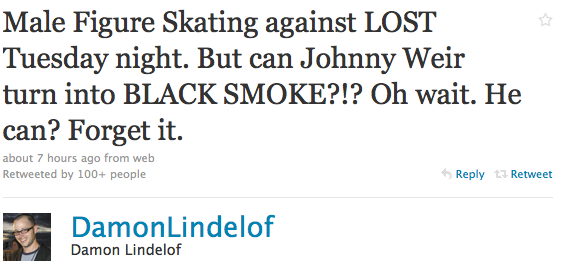
I do wonder a little what happens to Lost’s ratings tonight when all the homosexuals suddenly disappear to watch Johnny. (Although homosexuals are historically underrepresented in Nielsen households, obviously!) Anyway-we don’t care if tonight’s the night that Hurley finally dies. See you next week, eternally irritating TV show!
Dru Hill, "Love M.D." (And The Mastery Of R&B Ridiculousness)
The millions-selling Baltimore R&B; quartet Dru Hill are set to return in April with their first new album in eight years. Original members Sisqo, Nokio and Jazz are joined by a new member, Tao, who replaces Skola, who replaced original member Woody in 2000. The album is called InDRUpendance Day, a title that would probably be worth a post of its own. (If only to serve as a reminder that the folks who brought the world Sisqo’s monumental solo smash “The Thong Song” haven’t lost their sense of the ridiculous.) But even better, they’ve made a video for a new single, “Love M.D.”
A Dru Hill video is always worth repeated viewings. Dru Hill videos are bananas. State-of-the-art when it comes to the kind of over-the-top, they-can’t-be-serious, deep-schlock cheese that R. Kelly would lift to operatic new heights with the Trapped In the Closet series. So let’s take it from the top. Here’s what happens:
1) We learn in the intro, which is set to a different song, that a friend of the group has been at some sort of party where a stripper sat on his lap and fed him ice-cream. A video of the incident exists and the woman this man shares his mansion with watches it on his lap top while he’s sleeping on the couch. So she assaults him with a golf club. Having somehow survived the attack, the man runs out of the house.
2) Dru Hill dance and sing in the foyer. Jazz summarizes the song’s meaning, though with words that seem to understate the seriousness of the situation: “Need an opinion, unbiased, someone to talk to/An outsider, someone who understands what we’re going through/Lack of communication’s breeding this separation/And I don’t wanna lose you!”
3) The man creeps back into the house while his woman is sleeping. She wakes up and throws a wine glass at him. He ducks. They argue and grapple and she falls down. (He has maybe pushed her down?)
4) Tao takes a bath in a tub surrounded by candles and rose petals, and gets a back massage from a different woman.
5) The man and his girlfriend both cry.
6) Sisqo does a crazy sort of Matrix-bullet-dodging-sequence version of the moonwalk. He is a good dancer.
7) The woman’s make-up is smeared. The man has a split lip and a sore jaw and is missing a tooth. Presumably the results of the bludgeoning with the golf club.
8) The woman looks at the man. Her eye twitches, her lip curls. The man looks at the woman. He mouths the words, “I love you,” and begins to crawl across the floor, on his fists, to where she’s lying on the couch. Stopping about halfway there, he reaches out to her. She reaches her hand back to him. They have to really stretch, though, because they are at least four or five feet away from each other. And moving in slow motion. Finally, their fingers touch. And I don’t know whether it’s more like the Sistine Chapel or E.T. or the end of that wonderful new Erykah Badu video. But, wow, bananas!
Despite that, and despite the lyrics, I like the song. I like the big organ chords that drive the melody and the guys’ voices sound gritty and strong. I like it much more than I like most Dru Hill songs. To be honest, though, there is really only one other Dru Hill song that I like. But I don’t just like it. I love it. As remixed by Jermaine Dupri, and featuring him and Da Brat, the So So Def remix of 1996’s “In My Bed” is one the great jams of R&B;’s bling era. I think of it like Ginuwine’s “Pony” or Blackstreet’s “No Diggity”-songs that rise above a genre that has too often seemed wilted beneath the dominant shadow cast by Kelly.
On the same album, their epynonomous debut, another song, “I Never Make a Promise,” fell far too far into Boyz II Men territory. The video, though, supplied the edge. Maybe too much edge. Borrowing notes from “Janie’s Got a Gun” and The Cider House Rules or Eve’s Bayou, the milquetoast love song is depicted as a horrific story about alcoholism and incest. And Sisqo brings a pet tiger to a backyard family picnic.
Similarly, “5 Steps” takes a pretty standard gospel tune and turns it into a very dramatic, very confusing tragedy-this one seemingly about coming of age, loyalty, love and martyrdom. Sisqo forgets his gym bag at a basketball court and it somehow leads to his friend being killed in a Backdraft-style explosion after saving two children from a burning building. A white dove symbolizes the fallen hero’s soul ascending to heaven.
Lastly, and best and worst of all, in what plays as both an ill-conceived homage to and a genius-level spoof of the Leonardo DiCaprio vehicle based on Alexandre Dumas’ 150-year-old classic The Man In the Iron Mask, the video for 1998’s “These Are the Times” finds Nokio, Jazz and Woody dressed up the like the three musketeers, helping a bodice-ripping damsel save the blonde-haired good Sisqo, who has been unjustly imprisoned, and masked, by the evil, brown-haired Sisqo, who is his twin brother, and Louis XIV, the king of France. There is lots of hammy acting, choreographed sword fighting and hats that push right past any notion of fashion or taste and into the purple-feathered sublime.
That Von Trier "Taxi Driver" Remake
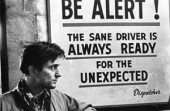
I’d be happy to be wrong, because it would be pretty crazy, but rumors that Martin Scorsese and Robert De Niro are planning a remake of Taxi Driver with Lars von Trier should be viewed with extreme skepticism if not outright disbelief. Here are some words and phrases that might help you reach the same conclusion: “it is being suggested,” “is said to be,” “remains to be seen,” “he may now feel,” “neither confirmed nor denied,” “Lars von Trier,” and “the prospect… has been discussed enthusiastically.”
Nick Denton asks Gawker Editor To Step Down, Purchases Cityfile

Nick Denton has de facto fired Gawker editor Gabriel Snyder; and announced the purchase of Cityfile. On Friday, Snyder announced Gawker’s record traffic. Remy Stern is now the editor of Gawker. (Stern, a founder of Cityfile, has desired the top Gawker job since at least 2004.) Two memos circulated in-house, dated one minute apart.
From Denton’s memo regarding Cityfile, sent to the staff:
For the first few years of Gawker Media, the business press had one
abiding preoccupation: when are you going to sell out? Today we’re
giving the M&A; gossips something else to talk about. The company is
making its first acquisition: Cityfile, the New York news site founded
by Remy Stern. The price is not being disclosed.
Cityfile will be the New York and media industry channel on Gawker,
alongside Valleywag and Defamer, our tech and entertainment sub-sites.
Cityfile’s 2,000-plus profiles of New York notables will be the
centerpiece of our new topic and people pages. And Remy Stern, a
former writer on several Gawker sites and editor at the now-legendary
Radar magazine, will take over as editor-in-chief of Gawker. He starts
on February 22nd.
We had hoped to persuade Gabriel Snyder to stay in a management role.
But he’s moving on. With help from an awesomely strong team of writers
and the new Gawker.tv operation, Gabriel doubled Gawker’s audience
during his tenure (http://bit.ly/c6BXk8.) To anyone out there looking
to build up an online property: snap him up quickly.
Does this mean Gawker is going on an acquisition spree?
Well, it’s a question of scale. Each of the Gawker titles does already
have more than 1m US visitors a month — making them usually the
largest or second largest blog title in their category. Nevertheless
the threshold of advertising success does continue to rise and we’re
increasingly competing online with TV and newspaper groups.
Moreover, we’ve long actively managed our portfolio of properties,
selling Consumerist to Consumers Union last year, for instance — or
closing down unsuccessful properties. To achieve critical mass in
entertainment and tech, we have indeed looked at a few opportunities
in the last few months. If online media is consolidating, we’d rather
be a consolidator than consolidatee. And revenue growth of 22% in 2009
provides the resources. (Deal ideas? Contact Gaby Darbyshire.)
Don’t get too excited, however. The successful launches of Jezebel and
io9 confirmed our belief that it’s usually more effective to build
than buy. Lifted by the iPad launch and the late-night TV wars, our
nine sites — all launched inhouse — drew a US audience of more than
14m in January. Our best editorial investment continues to be the
recruitment of great writers and producers on our own sites — and the
pursuit of hot stories.
Nick
From Gabriel Snyder’s goodbye memo:
For reasons which I’m not too clear on, but I’m sure Nick Denton will
explain momentarily, I am being replaced as editor-in-chief of Gawker.
Honesty is Gawker’s only virtue, so it seems inappropriate to engage
in the usual corporate euphemisms of “wanting to explore new new
opportunities” or “take a larger role in the company” or “spend more
time with my family” (though eighteen-hour days and seven-day work
weeks do take their toll on personal relationships), so I’ll put this
as plainly as we’d report any other masthead ouster: I am being
canned.
Building this website into what it is today — a big operation with 11
writers, a regular source of national news and a challenger to the
mainstream media organizations that it once mocked — has been the
best job of my career. Transitioning from print to online meant
adopting an entirley new biorhythm. Transitioning from writer to
editor has meant learning to bask in the reflected glory of the
talented staff who contribute every day. I love Gawker and adore the
crew that makes it happen.
You deserve all the credit; my role has been to push you to be
yourselves: Alex Pareene’s incisive political commentary, John Cook’s
dogged reporting and clear-headed analysis, Brian Moylan’s ability to
enunciate conversation-starting ideas, Richard Lawson’s ability to
produce dazzling copy at superhuman speeds, Ryan Tate’s cliche-free
coverage of Silicon Valley, Hamilton Nolan’s workhorse ethic and
humor, Doree Shafrir’s gimlet-eyed appraisals of the culture and
society around her. Waking up each morning to the work of Adrian Chen,
Maureen O’Connor and Ravi Somaiya is a pleasure. Watching Foster Kamer
dance on the stage each weekend is a joy. You, without a doubt, make
up the strongest staff Gawker’s ever had, and make the site the best
it’s ever been.
Eighteen months ago, when I first sat down with Nick to discuss taking
over the Gawker helm from him, I saw a huge opportunity to build a
site from its roots as an intimate discussion among Manhattan’s power
elite and build it into a national news brand (an aspiration that
seems to come up every time there’s a masthead shakeup around here).
Attaining those goals have been the biggest accomplishment of my
career. As I saw it, Facebook, Twitter and smaller blogs had slowly
encroached on the role Gawker once served. Among the most difficult,
though most rewarding to the site, efforts was to take the site from a
bankers’ hours schedule to publishing 24 hours around the clock,
weekends included. I believed the site could be grown beyond its
traditional audience by focusing on news from the nation’s four
cultural capitals (New York, D.C., L.A. and San Francisco) — which
became even more clear when I was given the task of integrating former
standalone sites Defamer and Valleywag into the flagship. Oh, and then
there have been the stories. It’s become common to see national
newspapers and broadcasts cite Gawker on vast array of stories: the
U.S. Kabul embassy security dudes behaving badly, the Hipster Grifter
saga, leading the entire media for a weekend on the Balloon Boy
fiasco, those pictures of Katie Couric dancing, pillorying Harold Ford
through simple questions, Annie Leibovitz’s financial meltdown, the
Late Night Wars, Facebook privacy, Anna Wintour … more than I can
count. I was determined to compete with the biggest news sites on the
internet. And today, I am glad to say it does.
But the history of Gawker Media careers shows that they tend to burn
bright and fast. So it shouldn’t have come as a much of a surprise
when our mercurial owner told me he’s hatched other plans for Gawker.
He offered me a new, temporary position as an assistant managing
editor of Gawker Media as a holding job, which I have declined. I
can’t see how I’d be in a position to succeed at the role going into
it with one foot literally out the door. I’ll be editing the site
until Friday. After that, please stay in touch [REDACTED].
And needless to say, as of now I am on the market and will be beating
the media bushes for my next opportunity.
I will miss you all.
Best,
Gabriel
Beyoncé Is An Illuminati Puppet -- But One Man Knows the Truth
by Tara Ariano
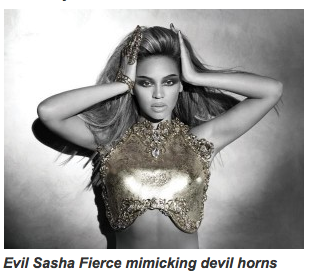
One day in the early 2000s, I received an unsolicited email from someone I didn’t know; if you had an email address then, you probably did too, daily, and most of the time ignored such notes. But there’s spam, and then there’s spam. It began: “If you are a time traveler or alien disguised as human and or have the technology to travel physically through time I need your help!”
And it continued:
My life has been severely tampered with and cursed!!
I have suffered tremendously and am now dying!
I need to be able to:
Travel back in time.
Rewind my life including my age back to 4.
I am in very great danger and need this immediately!
I was a little hurt when I discovered that the sender had a pretty long list of recipients for his note. And in the months and years that followed that email, media consolidation seemed to affect the Internet as much as it did print and broadcasting, making it harder for the average user to chance upon the thrilling manifestos of singular visionaries like my correspondent, which is why I was so excited to find The Vigilant Citizen.
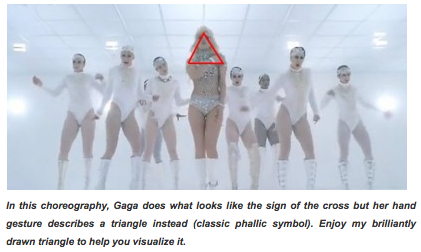
The first VC post I read was a look at Lady Gaga’s “Bad Romance” video, presented to me by the tireless content “recyclers” at Oh No They Didn’t. I’d seen the video and already thought it was a fairly dark depiction of human sex trafficking (plus dance routines); little did I know it’s actually about “the dark and ritualistic inner-workings of the entertainment industry.”
In the first paragraph, the author refers to previous posts describing Lady Gaga as an “Illuminati Puppet,” so for VC, this video fits that narrative perfectly. Gaga begins in a sensory-deprivation tank (of the sort used on victims of mind-control techniques). She’s drugged (ditto). She’s eventually delivered to a room in which a bed is flanked by taxidermied gazelle heads (which “symbolically refer to Baphomet, the horned idol of Western occultism”). And she doesn’t set her master on fire to escape her fate as a sex slave, as it might have appeared to me: she presents him as a burnt offering to Baphomet in exchange for her fame.
Her final dance scene finds her costumed in red as a sign of her initiation into the Illuminati-and in case that sign wasn’t clear enough, her “eye in the triangle” gesture should eliminate all doubt. You know, eye in the triangle? Freemasons? That thing on money? …Right?
Here’s the genius of VigilantCitizen.com: it combines the urgency of apocalyptic paranoia with the eggheaded fun of semiotic analysis. Conspiracy theories are hard to resist; you probably know otherwise normal people who, despite the evidence to the contrary, believe that 9/11 was an inside job, or that the moon landing was faked, or that vaccines cause autism. Conspiracy theories involving the U.S. government are all the more believable given that it spent the 20th century screwing up its citizens both intentionally (Tuskegee syphilis experiment) and through its negligence (Love Canal). Plus there’s all that business around America’s founders and their connections to Freemasonry-and when you start thinking about whether Freemasons run the country, it won’t be long before you’re on to the Illuminati and the New World Order and the secret ways in which our government controls us without our even knowing it. Vigilant Citizen has taken this sort of thinking-popular amongst intense undergrads around 3 a.m. in a dorm common room-and turned it into an impressively detailed website.
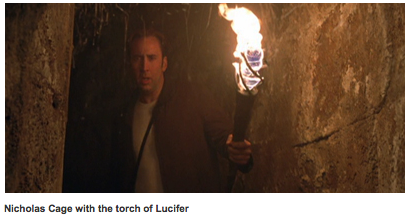
A word about our guide. The Vigilant Citizen is, of course, anonymous. From the site’s FAQ, we learn he is male; he has a fiancée; he lives in Eastern Canada; and he identifies himself as a “mystic Christian.” The “About” page also informs us that he holds a B.A. in Communications and Politics, and has worked as a producer in the music industry, in which capacity he learned things about show business that the rest of us will never see: “Through my experiences and my contacts, I have discovered some of the darker aspects of the entertainment industry which I found were in direct connection with my studies in occultism. My understanding of the state of mind that prevails in the higher levels of the ladder makes it probably easier for me to decifer [sic] the symbolism in music videos than it is for everyday people.”
What makes VC so fascinating to me is that even though his general point seems to be that we need to be on our guard against indoctrination by the Illuminati, so that they can’t enact their plan to bring about a New World Order via mass genocide that would sufficiently thin out the world population and thus clear a path for a one-world government (obviously), his writing doesn’t suggest a tremendous amount of anxiety about the imminent destruction of our freedoms or our way of life. He’s way more interested in outlining the symbolic evidence for his worldview. Any number of commentators have already dealt with the various monuments in Washington, DC, and VC gives some attention to those as part of his series on “Sinister Sites” which also include the Supreme Court of Israel, Rockefeller Center and the Manitoba Legislative Building. But I’m pretty sure the only person to see Illuminati symbolism in the video for Paramore’s “Brick By Boring Brick” is VC.
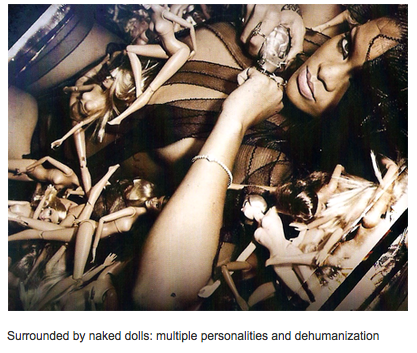
VC’s thesis with music videos tends to be that the artist is using the medium to send viewers coded messages about the occult-tinged rituals in which he or (usually) she secretly had to participate in order to become famous. For instance: Rihanna. VC presents several recent photos in which she is covering one of her eyes, and explains: “[T]he occult meaning of hiding one’s eye… can be traced back to the ‘eye of Horus’ of Egyptian mythology. This symbolism seems to have evolved into a kind of ‘signal,’ flashed by the artists who have been initiated into the select circle of Illuminati pop stars.” So therefore, Rihanna’s video for “Russian Roulette” isn’t a stylized representation of the notion that love, like Russian roulette, is a dangerous game; it’s actually a depiction of Monarch programming and Illuminati mind control. Or: Beyoncé. Her reinvention as Sasha Fierce is not just an artistic experiment or a marketing gimmick but a symbolic representation of an artist taken over by evil to obtain success. (On the related subject of Chris Gaines, VC has, so far, kept silent.)
VC is somewhat less convincing when, for example, he takes on Walt Disney’s Pinocchio. For one thing, his interpretation of nearly any entertainment targeted toward children is tainted by his belief that Monarch programming, in which Disney movies or The Wizard Of Oz are used to calm mind-control subjects and induce a dissociative state, is still practiced by the Illuminati today. (It’s why VC is so alarmed by Lady Gaga’s video for “Paparazzi,” at the end of which she’s wearing sunglasses that evoke Mickey Mouse ears as she poisons and kills her lover.) In the case of Pinocchio, VC starts with the biographical detail that Carlo Collodi, author of the book on which the film is based, was an active Freemason, and uses that to inform his reading of the film. So Geppetto doesn’t pray to the regular old God to make Pinocchio a real boy; he prays to “the greater God (the great Architect of the Masons).” Pinocchio’s transformation into a donkey is a reference to Apuleius’s Metamorphoses, “a classic work studied in Mystery schools such as Freemasonry.” Also in Comp. Lit. courses in any university anywhere!
And maybe the episode in which Pinocchio ends up in Stromboli’s puppet show has nothing to do with the way the Illuminati use entertainers as their “puppets”; maybe it’s a way to suggest to children that it’s less important to be famous than it is to be good.
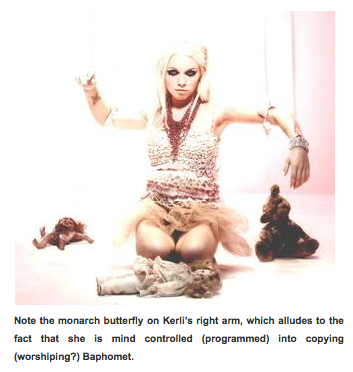
This is one of the problems with VC’s symbolic analysis: certainly, it is possible to read occult themes into artistic works if that’s what you’re looking for. But it’s possible to read nearly any theme into an artistic work if you have a basic working knowledge of a culture’s most enduring story elements. I’m sure Forrest Gump is beneath VC’s notice, but I remember when that came out that both liberals and conservatives considered it a scathing indictment of their opponents, and both factions could use the events of the film to make convincing arguments. The reason “There’s no place like home,” from The Wizard Of Oz, might be used in Monarch programming (if you believe Monarch programming really happened-or is happening all around us right now) is that “There’s no place like home” is a theme that goes back to The Odyssey.
VC writes: “Pinocchio went through the hardships of initiation and came out of the darkness of ignorance. He emerges from tomb [sic] resurrected, like Jesus Christ. He is now a ‘real boy’, an illuminated man who broke the shackles of material life to embrace his higher self.” Sure-or, he undertook The Hero’s Journey, which underpins nearly every work of fiction from The Aeneid to The 40-Year-Old Virgin.
But look, VC isn’t trying to get an A on an English paper; he’s trying to help his readers to an awareness of the ways our country’s secret rulers use mass culture to control us, and he’s well prepared to answer your dubious questions. Like, if all this Monarch business happens in secret to fulfill our overlords’ evil ends, why would they allow hints to pervade music videos? VC answers in the FAQ:
This is a great question and it can only be explained by understanding the way the occult elite thinks. They firmly believe (as well as all ancient civilizations) that symbols can deeply affect the human psyche. Many occult exercises focus on meditation through symbols, which they believe leads to a higher state of consciousness. The same knowledge is applied to the masses through movies and videos but to attain another result: to dumb down and to deshumanize [sic]. Sounds terrible, but these are the times we live in.
So in other words, the Illuminati think we’re too dumb to catch on-but the Illuminati didn’t count on VC not only to find out there is an artist called Kerli (or a band?), but to submit her (their?) “Walking On Air” video to the most rigorous possible scrutiny. Foiled!
Another question: if whistleblowers in movies like The Constant Gardener and Michael Clayton end up dead, how is VC allowed to continue dropping all this truth on the Internet, exposing all these shadowy figures’ nefarious plots? Well, last year he wrote about the way big-budget movies like National Treasure and Angels & Demons revolve around real secret societies, and act as propaganda, to spread disinformation about their actual rites and ends and lull the public into complacency about them. If the Illuminati are aware of VC-and it’s impossible to think they’re not; surely, they follow him on Twitter!-maybe they’re letting him continue in his work because forcing him into silence would just prove to his readers exactly how right he is.
Quibbles aside: I really do love reading The Vigilant Citizen. His posts are so well and carefully crafted that when I find myself getting convinced and/or creeped out by them, I’m forced to do my own research in order not to give myself apocalyptic nightmares. And since I am also someone whose training as an English major means I came out of 2012 certain it was a stealth Socialist text, and the vampire “thriller” Daybreakers impressed by its allegory on responsible resource management, I appreciate that VC respects the topics of his posts enough to subject them to rhetorical deconstruction.
Last week, several hours after the news of Alexander McQueen’s suicide had hit the wires, VC tweeted, “His last creations were secret society/mind control/occult themed.” So first of all, VC isn’t finished scrutinizing Lady Gaga and all her known associates (McQueen having designed many of the costumes in the “Bad Romance” video). And second of all, maybe this means he’s going to do a post soon on McQueen’s work and death, and if he does, it will be a mesmerizing masterpiece of WTF, and will finally answer the question of what the collections of Alexander McQueen have in common with the Denver International Airport.
And you guys, seriously, what is up with the Denver International Airport?

Tara Ariano is the Managing Editor at Sling.com. She also co-anchors the podcast Overwhelming Positivity
and has a personal blog that she rarely updates.
Let's Not Forget That Alexander McQueen Worked For Worst Industry Ever

It is sad that Alexander McQueen took his own life, says Telegraph religion editor/Anglican priest George Pitcher. But there’s something he thinks that we’re ignoring while we focus on the tragedy of a man at the top of his field who could not overcome whatever sadness he found too painful to cope with: The fashion industry is bad, bad, bad. In fact, it’s
one of the least attractive legal activities on earth, populated by weirdo artists, freakish PRs and emaciated and mentally disordered models. To be even tangentially exposed to it is to enter a world of phoneys and airheads, mutually massaging the pointlessness of each other’s professional existence, self-regarding to a degree that would make Narcissus blush, committed only to ripping off a market made docile by cocaine, champagne and the odd canapé. Fashion is a chimera of a real industry, the absence of which would harm no one other than its self-serving catamites and courtesans. It is a disgusting place to make a living.
He adds, “I just thought I’d make that clear, because nobody else seems to have done so over the past couple of days.” Okay!
